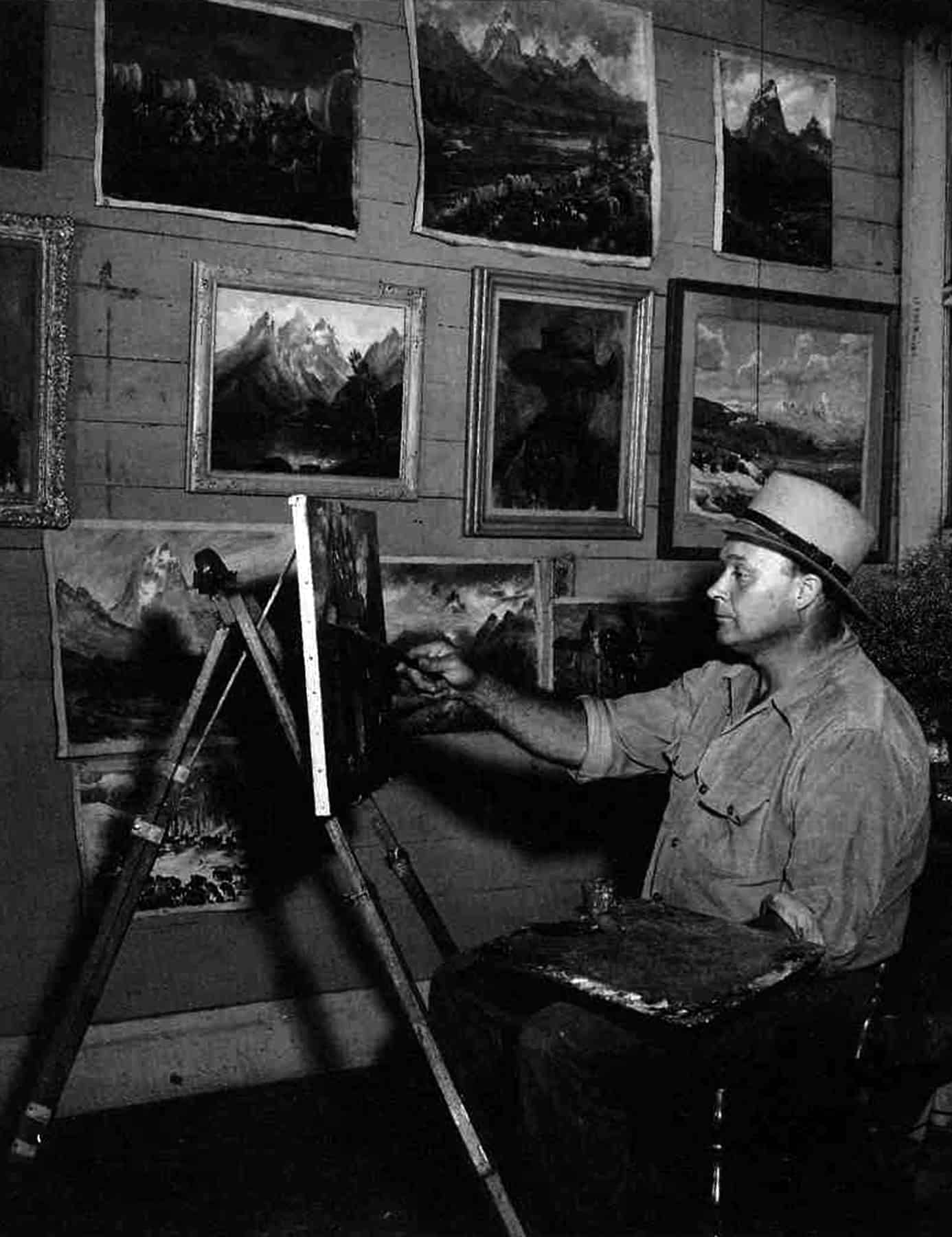Read The
Current Issue
Art Evolution
How Jackson’s gallery scene grew to be one of the most vibrant in the country.
// by jim mahaffie
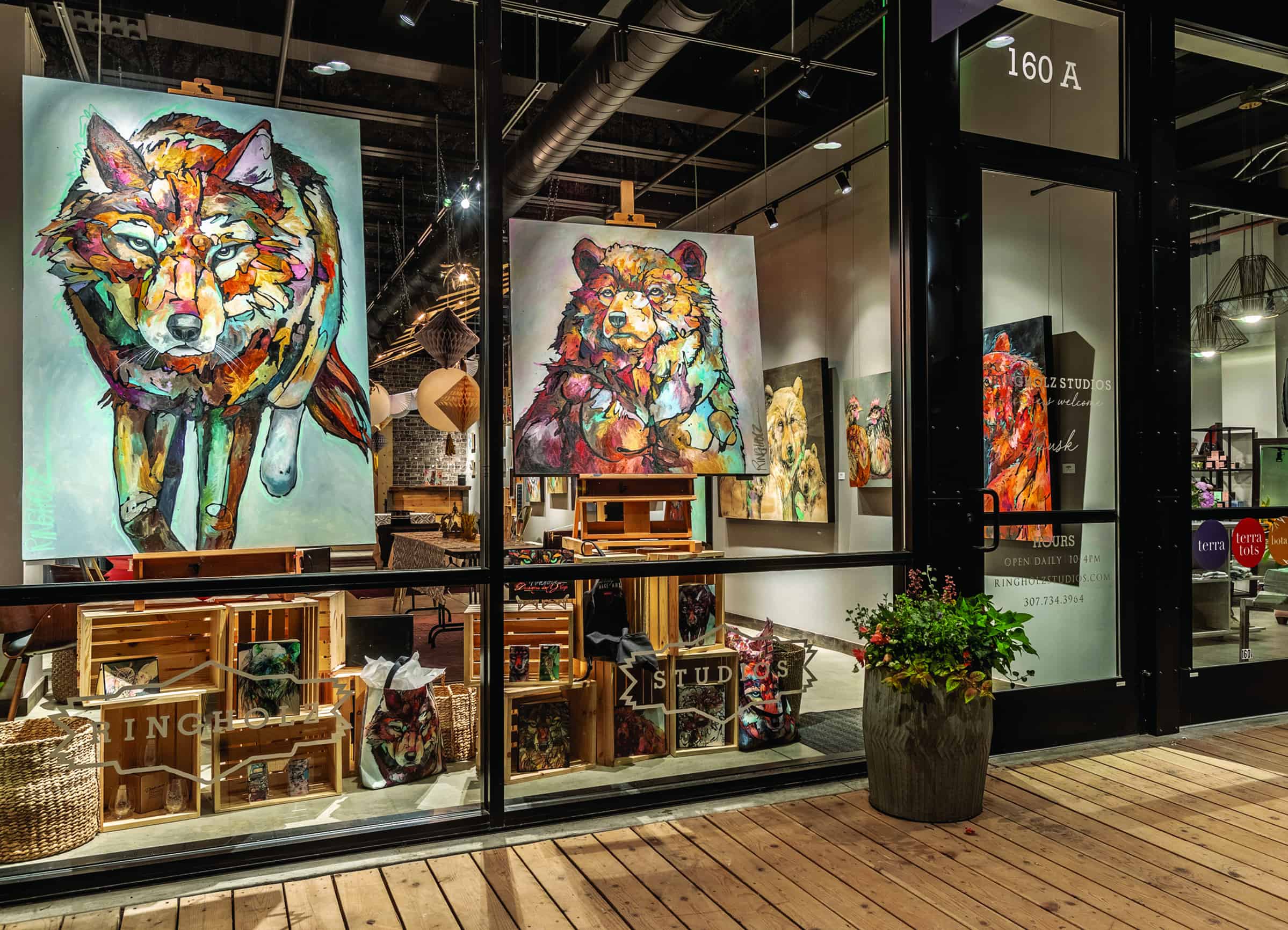
Trotting on your horse down the dirt road to Jenny Lake in the 1920s, you would have passed a tent. You likely would not have guessed that, tucked under the soaring Cathedral Group peaks of the Teton range, with painted canvases hanging from a clothesline out front, that humble tent was the leading edge of an arts community that, a century later, would be rated one of America’s finest.
The tent was the studio and showroom of painter Olaf Moller. Born in Denmark, he immigrated with his family as a child, and studied under painter N.C. Wyeth and at the Academy of Fine Arts in Philadelphia. His family settled in Idaho, and he came to Jackson to paint every summer throughout the 1920s. Across his tent’s roof and later his studio cabin was a giant sign that said PICTURES. Inside were paintings, photos, and postcards for sale.
Artists before Moller painted, and photographed, the Tetons, but Moller was the first to sell his paintings right at the eastern base of the range. Moller had neighbors before Grand Teton National Park was established in 1929—an eclectic collection of artists, photographers, adventurers, and climbers who, like him, spent summers in the Tetons. “Jackson Hole is outstanding in its scenic values and the mecca of numerous artists during the summer season,” read the Salt Lake Tribune in 1939. “An artist with his easel, by the roadside, in front of the Teton Range, is no uncommon sight.”
Others that sold their works from Moller’s “gallery” included Archie Boyd “Teton” Teater, a prolific landscape artist from Idaho who studied at the Portland Art Museum and Art Students League in New York. Another was Kansas-born photographer Harrison Crandall, who came to Jackson with his wife, Hilda, in the summer of 1922 to honeymoon. The Crandalls set up a darkroom in their tent on String Lake and sold photos and postcards there and at the JY Ranch and Moran General Store. In 1923 the Crandalls bought land and began to build a homestead on Jenny Lake. The Crandall Picture Shop and Studio was completed in 1927 and is now the site of the Jenny Lake Visitor Center. Here’s a look at how Jackson’s gallery scene got from then to now.
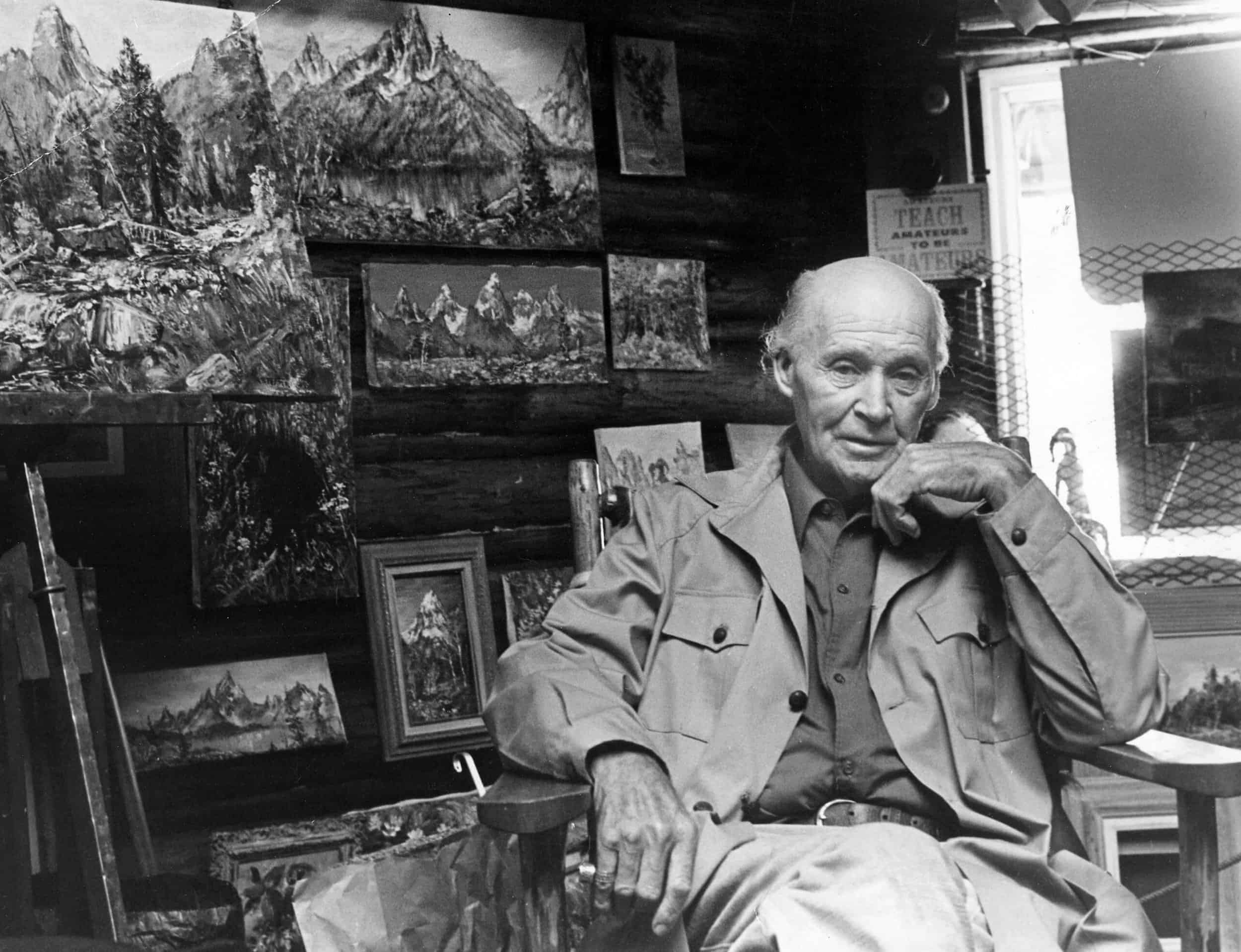
Born in Idaho and kicked out of eighth grade for drawing instead of doing homework, Archie Boyd “Teton” Teater (1901–1978) summered in the Tetons with pals Olaf Moller and legendary mountaineer Paul Petzoldt, who helped sell their art to tourists on his climbing trips. In 1941, Teater built a cabin to use as his studio and gallery—a big step up from selling paintings out of his tent on Jenny Lake and at pop-up stands on the Town Square. (Teater’s studio still exists today; it is home to JC Jewelers, although its current location on the Town Square is not where it was in Teater’s day.)
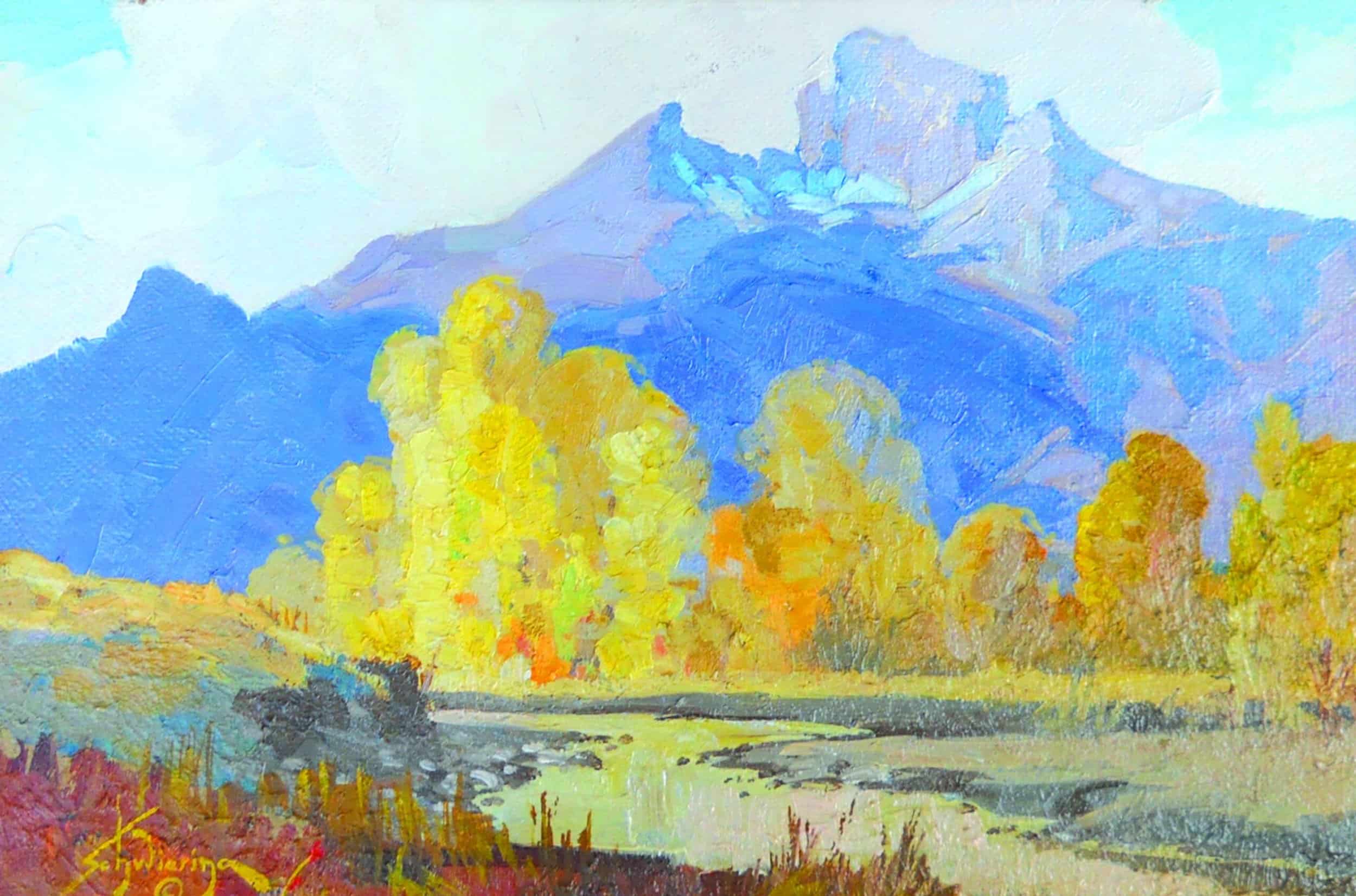
Jackson Hole’s first year-round resident artist was Wyoming-raised painter Conrad Schwiering, who came to Jackson in 1947 and began selling paintings out of a trailer on the Town Square. Schwiering’s father was a dean at the University of Wyoming, and Conrad grew up in Laramie. While studying at the Art Students League in New York City from 1939 to 1941, he met Western wildlife artist Carl Rungius, renowned for his paintings of animals in their natural environment. A nationally known painter, Schwiering worked on displays at New York’s Museum of Natural History before coming to Jackson. Schwiering organized a show of Wyoming artists in 1947 that traveled around the state.
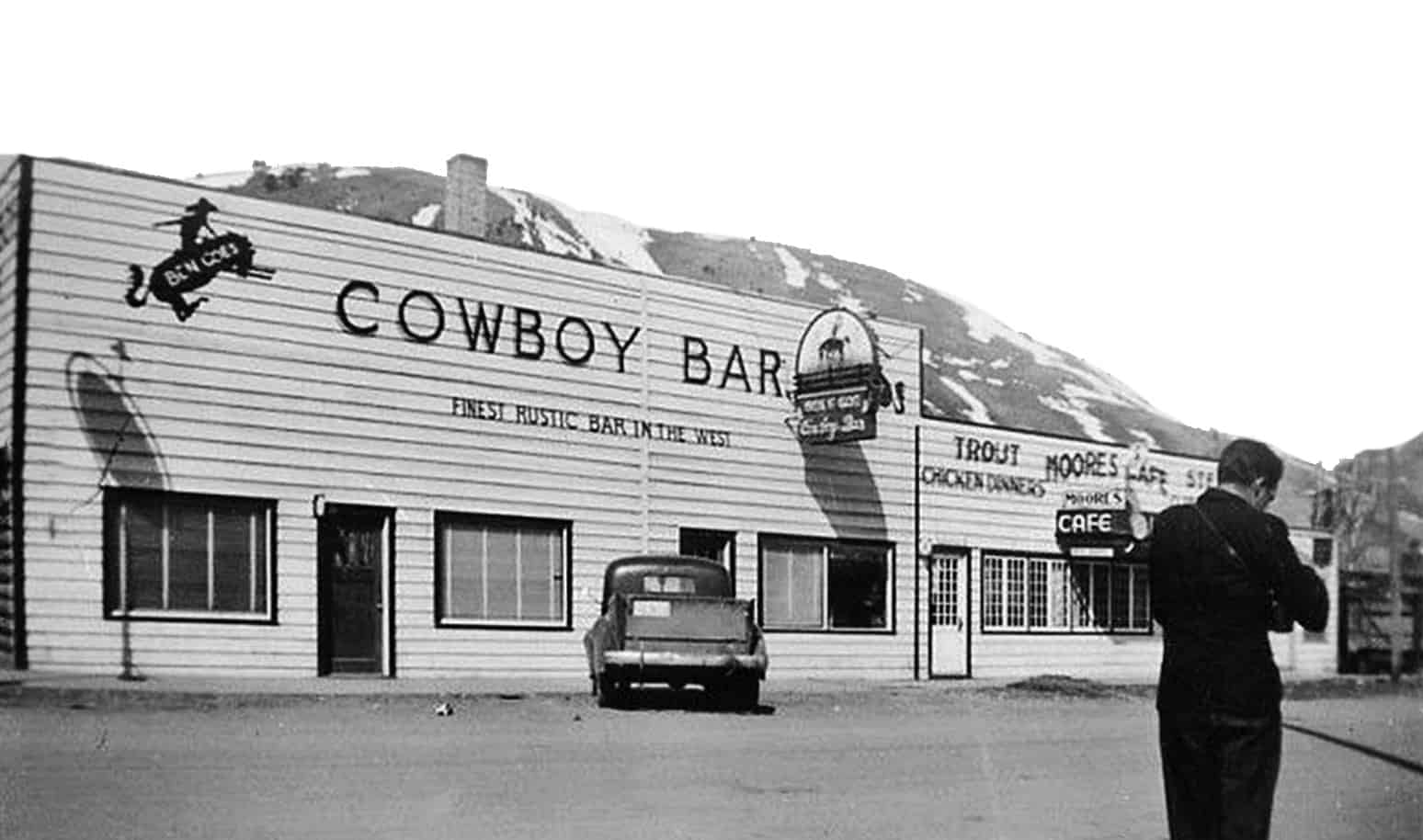
Moore’s Café, a popular gathering spot next to the Cowboy Bar, began hosting art shows in 1938. That June, Moore’s owner and chef, Jack Moore, and his wife, Berta, held a solo exhibition for their friend Archie Teater. This show was so successful the café did a larger one the following summer. It included work by Moller, Teater, naturalist Olaus Murie, and painters Bert Humphrey and Earl Reed. When the show traveled to other destinations in 1940, it added works by Florence Ware, a painter and professor of art from the University of Utah, and the first in a talented and distinguished line of women artists who brought more attention to the Jackson Hole art scene.
After World War II, many more art lovers, patrons, travelers, and collectors discovered Teton landscapes, wildlife, and Western scenes, and demand gave rise to new galleries, art fairs, and exhibits. By the 1960s, the town had transitioned from ranching and cattle to tourism and the trappings of wealth, such as art. Jackson joined the ranks of other “miracle markets” (like Santa Fe, Scottsdale, New Orleans, and Charleston), where wealthy homeowners, a large transient visitor population, and beautiful surroundings combined to drive art markets. In 1962, a Jackson Hole Guide headline read, “Jackson Hole to Become Cultural Center for Wyoming and the Entire West.”
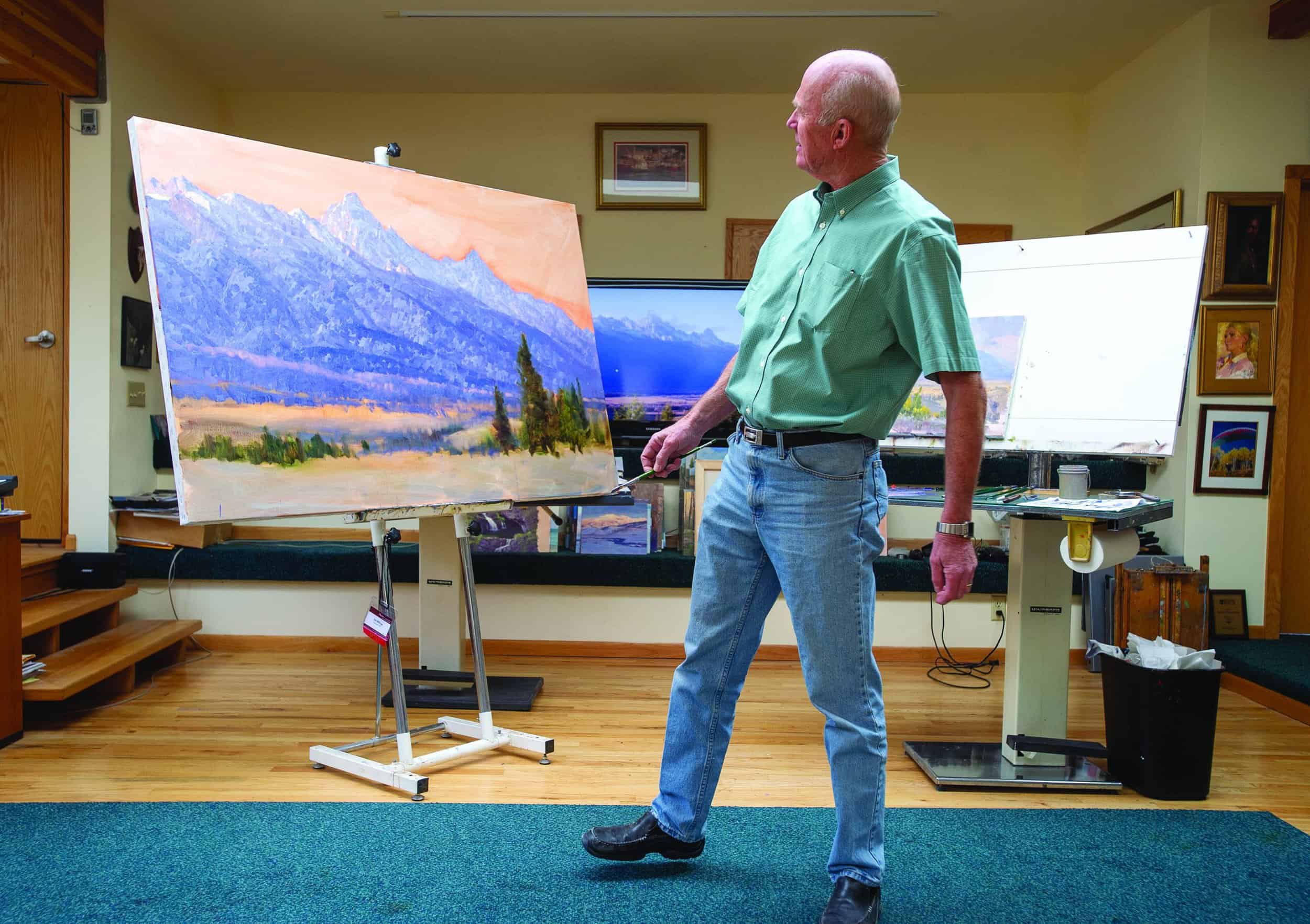
Early galleries expanded Jackson’s art horizons and attracted even more artists and national attention. In 1963, Dick Flood opened Trailside Galleries on Jackson’s Town Square, representing artists from all over the West. Wilcox Gallery (shown at right) opened in 1969 to sell the work of award-winning painter Jim Wilcox and several other artists and sculptors. In 1978, wildlife photographer Thomas Mangelsen opened Images of Nature (shown below), a gallery selling his fine art photography from around the world.
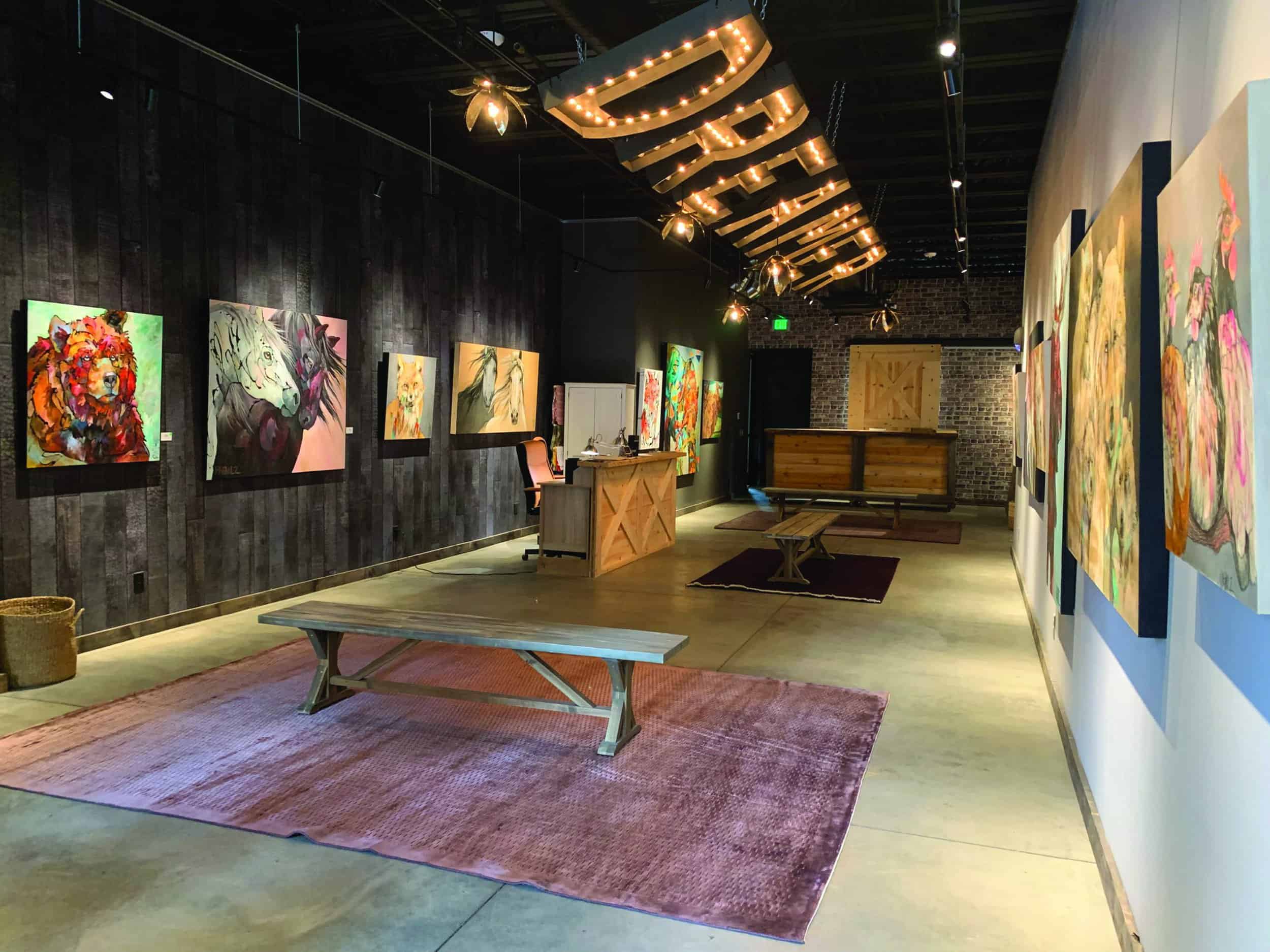
In 1948, Wort Hotel owners John and Jess Wort offered Conrad Schwiering balcony space at their hotel for the town’s first hotel gallery. Amid the gambling, showgirls, and rowdy bar scene was a small sign that read “Conrad Schwiering, Western Paintings” with a finger pointing up to the balcony where his artwork hung and sold for 12 years. While galleries selling traditional Western and wildlife art dominated the art scene for decades, in the early 1980s, Beth Overcast opened Center Street Gallery, which was the valley’s first to sell contemporary art. In the decades since, this segment of the gallery scene has exploded. Case in point: Ringholz Studios (shown above), which sells the colorful paintings and drawings of artist Amy Ringholz, who is based in Jackson, and has work in collections across the country. “Jackson Hole is well-known for traditional Western and wildlife artwork, and is adding more contemporary work with new and different artists arriving,” says current Jackson Hole Gallery Association president and Ringholz Studios manager, Ashley Quinn. Carrie Wild, an artist and co-owner of Gallery Wild says, “I see a really strong contemporary art market with newer work more abstract and colorful. Our artists use our natural beauty as an inspiration, and they are doing their own interpretations of it. Just like with traditional work, buyers go for cool art that they can take home and reminds them of their visit.”
Founded in 1962 and first led by Baroness Consuelo von Gontard of Melody Ranch, the Jackson Hole Fine Arts Foundation put on the first Jackson Hole Fine Arts Festival that year. Today, the Jackson Hole Gallery Association brings together top artists and galleries in its annual gallery guide. Founded in 1981, today it includes 28 member galleries.
Bar BC Ranch-born-and-raised writer and social historian Nathaniel Burt predicted Jackson’s art futurein his Jackson Hole Journal, published in 1983: “New West…where painters flourish and every other store is an art gallery of some kind. Someday Jackson Hole may be more famous for its artists in some form or another as it is now for its mountains.”
In Jackson Hole, the definition of “art gallery” is broad. Thanks to local businesses supporting local artists, you can buy a painting with your bagel at Pearl Street Bagels or with a beer at Snake River Brewing. Local restaurants the Blue Lion and Cowboy Coffee also exhibit the work of local artists.
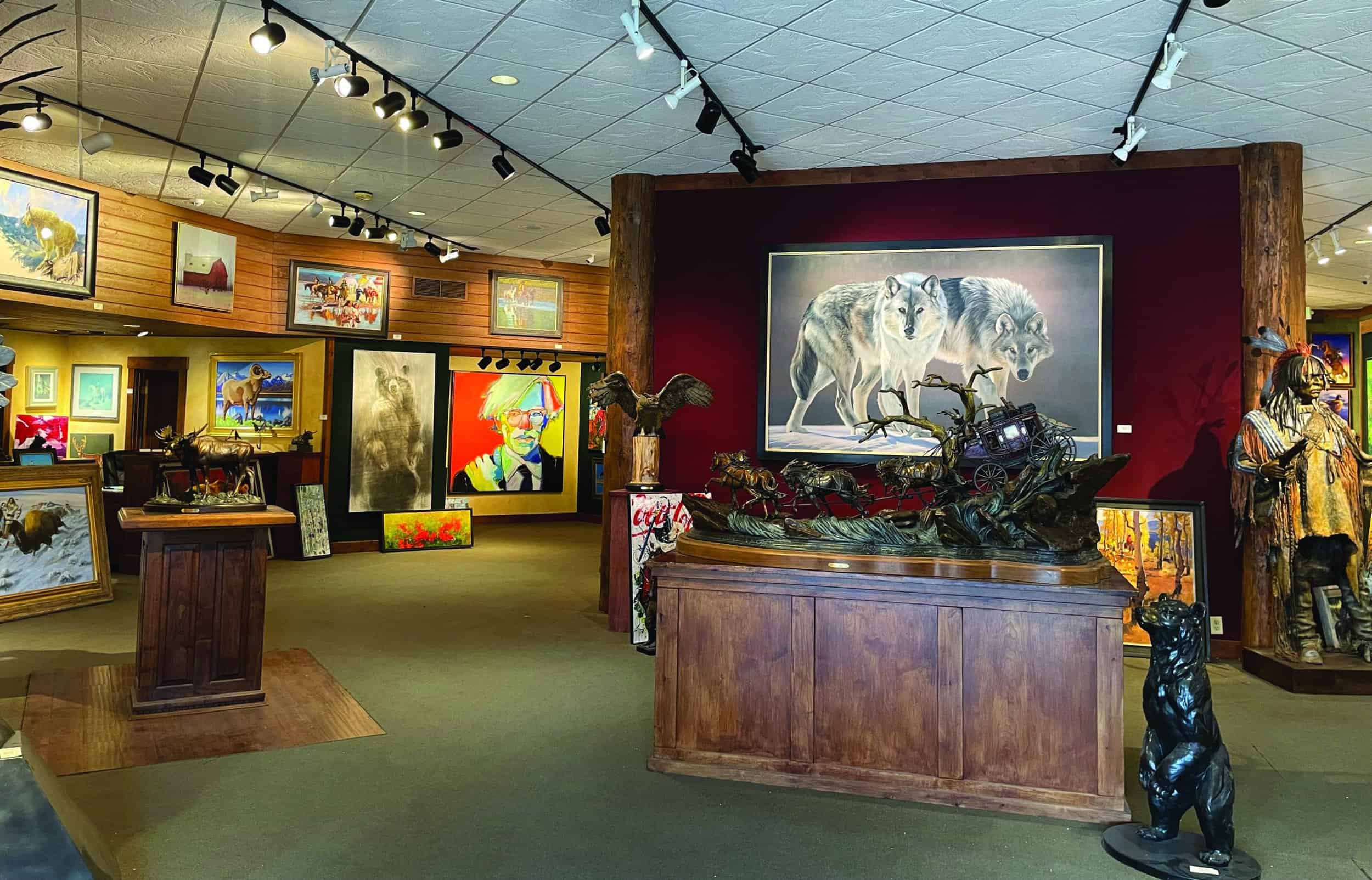
What’s the future look like for art galleries in Jackson Hole? “We’re a real success story nationally,” says Maggie Moore, founder of Artemis Art Advisory, an art appraisal and collection-management service based in Jackson. “New galleries are opening in Jackson, and Jackson is seeing young artists and entrepreneurs carrying on the traditions of Archie Teater and the Crandalls today. There’s something to be said for people going on vacation, seeing this incredible place, then visiting a true gallery, capturing it in a memento from their trip, and taking it home.”
1920s
Painter Olaf Moller spends summers in a tent on Jenny Lake then buys a cabin to host exhibitions and classes, billing himself in ads as an “Instructor in Portrait, Landscape, Still Life, Drawings and Paintings.”
1922
Harrison and Hilda Crandall honeymoon in Jackson Hole but quickly turn it into a business trip. They set up camp on String Lake with a darkroom, and sell postcards to dudes at the Moran General Store.
1927
The Crandall Picture Shop and Studio opens (on the site of the current Jenny Lake Visitor Center), selling photos, paintings, art supplies, and posters by artists including Olaf Moller, Charlie Russell, Winold Reiss, Stephen Leek, and Joseph Stimson.
1928
Archie Boyd Teater sells paintings out of a tent at Jenny Lake. Encouraged by his success, he rents a cabin on Jenny Lake from the Crandalls to display and sell his work.
1932
The Crandalls’ property becomes part of Grand Teton National Park—and the couple becomes the new park’s first official concessionaire.
1938
Moore’s Café (in the space that is now Local restaurant) hosts Archie Teater’s first solo exhibition, which includes paintings of Jenny Lake, the Tetons, and other Jackson Hole scenes.
1939
The Teton Artists Association creates an artists’ colony. The hub is the Jenny Lake studio of Olaf Moller, its first president, and his cabin hosts rotating exhibits in summer. These exhibits later move to Moore’s Café.
1942
Led by Harrison Crandall, renowned photographer Ansel Adams shoots his striking view of the Snake River winding toward the Tetons.
1945
After living in a truck bed, covered wagon, and the Railway Express office, Archie Boyd Teater opens a log cabin studio and gallery on the Town Square. It remained until his death in 1978.
1947
Conrad Schwiering arrives in Jackson. An impressionist who painted more than 500 Jackson Hole and Teton scenes, he was the town’s first year-round resident artist. His paintings were sold in a gallery inside the Wort Hotel.
1963
Dick Flood opens Trailside Galleries on Jackson’s Town Square, bringing several well-known artists and their work to the valley.
1969
Wilcox Gallery opens to sell the work of painter Jim Wilcox and other popular and successful western painters.
1978
Wildlife photographer Thomas Mangelsen opens Images of Nature, a gallery selling his fine art photography of wildlife and landscapes.
1983
The first Fall Arts Festival is held (it is still going strong today).
1990s
Center Street Gallery and Martin Harris Gallery bring contemporary art to Jackson, paving the way for other contemporary galleries.
1991
Legacy Gallery opens on the Town Square representing many well-known wildlife and landscape artists from around the country. It closes in 2019.
1998
West Lives On Gallery begins selling fine Western art. (West Lives On Contemporary opens in 2009 to meet demand for contemporary artwork.)
2004
Trio Fine Art, which is owned by local artists, opens.
2013
Trailside Galleries celebrates 50 years of selling Western art and sculpture on the Town Square.
2019
Jackson is ranked the number-one “arts vibrant” small community in the country in the fifth annual SMU DataArts Arts Vibrancy Index.
2019
Trio Fine Art becomes Turner Fine Art, which showcases Jackson-born painter Katherine Mapes Turner’s artwork, as well as other nationally renowned fine artists. JH

